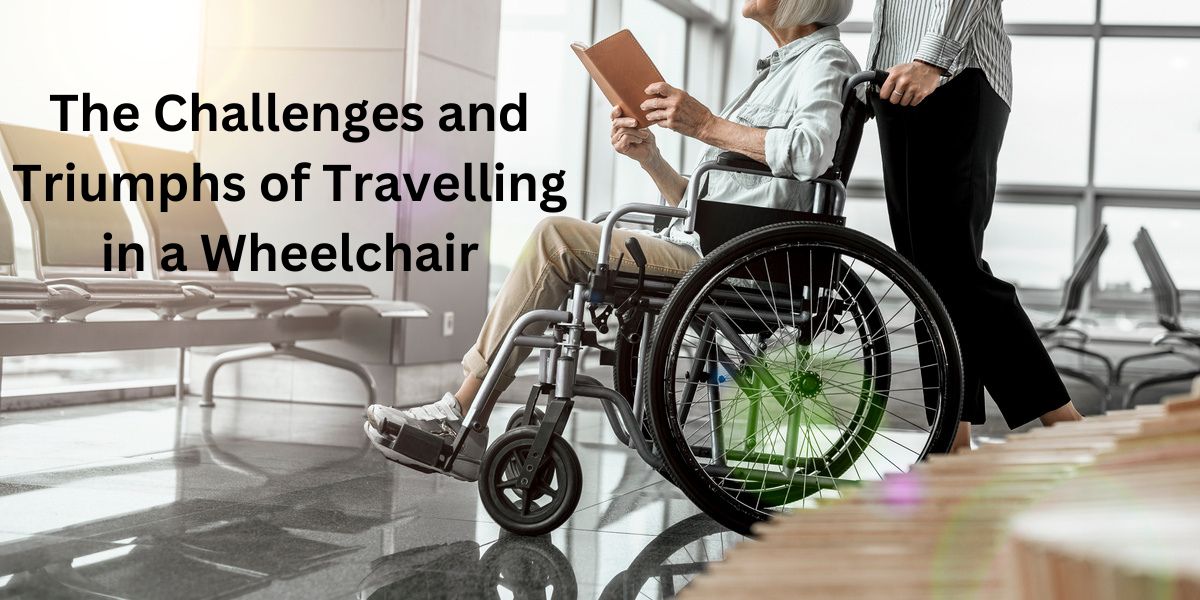Traveling is an enriching experience that opens doors to new cultures, landscapes, and adventures. For individuals navigating the world in a wheelchair, however, this pursuit comes with unique challenges and triumphs that unveil both the barriers and the incredible resilience required to explore the world.
The Benefits of Travelling In A Wheelchair

While travelling in a wheelchair comes with its own unique set of challenges, it also brings forth many benefits that enrich the overall experience in profound ways.
1. Perspective and Resilience
Travelling in a wheelchair offers a distinctive perspective on destinations. It invites individuals to engage with environments from a different vantage point, allowing for a deeper appreciation of accessibility or lack thereof. This unique viewpoint fosters resilience, as navigating through obstacles cultivates problem-solving skills and adaptability, enhancing personal growth and resilience in overcoming challenges.
2. Cultural Exchange and Inclusivity
Wheelchair travellers often find themselves interacting more intimately with local communities. The challenges they face often prompt locals to extend kindness, assistance, and a deeper understanding of inclusivity. These interactions create bridges of empathy, breaking down barriers between cultures and fostering a global community that values diversity and accessibility.
3. Enhanced Awareness and Empathy
Experiencing the world from a wheelchair heightens awareness of the everyday struggles faced by individuals with disabilities. This firsthand experience fosters empathy and understanding, prompting travellers to advocate for greater accessibility and inclusivity in all aspects of society, not just in travel.
4. Discovery of Adaptive Adventures
Travelling in a wheelchair opens doors to adaptive adventures and activities specially designed for individuals with disabilities. From adaptive skiing to accessible hiking trails and scuba diving programs, these activities offer thrilling experiences that defy conventional expectations and expand the possibilities for wheelchair users, highlighting that adventure knows no bounds.
5. Strengthening Community Bonds
The community of travellers in wheelchairs forms a tight-knit and supportive network. Shared experiences, tips, and recommendations strengthen these bonds, creating a supportive environment where individuals uplift each other and provide invaluable guidance for navigating the challenges of travel. This sense of community amplifies the joys and triumphs of exploration.
6. Inspiring Others and Driving Change
The journeys of wheelchair travellers often serve as a source of inspiration for others facing similar challenges. By sharing their experiences, they not only encourage others to pursue their travel dreams but also drive societal change by advocating for improved accessibility and inclusivity, making travel more accessible for future generations.
The Challenges of Travelling in A Wheelchair

1. Accessibility
One of the most prevalent challenges faced by wheelchair users when travelling is the lack of accessibility. Many destinations, despite progress, remain inadequately equipped with ramps, elevators, and accessible facilities. Historical sites, narrow streets in old towns, or rural areas often pose significant hurdles, limiting the freedom to explore.
2. Transportation
Navigating public transportation systems in many parts of the world can be a daunting task. Trains, buses, and even taxis may not be wheelchair-friendly, creating substantial barriers to movement. While some countries have made strides in ensuring accessibility, gaps still exist, making spontaneous travel a challenge.
3. Accommodation
Booking wheelchair-accessible accommodations can be hit-or-miss. Although hotels and lodging establishments are increasingly aware of the need for accessible rooms, the availability and quality can vary widely. Ensuring that a hotel room meets one’s accessibility requirements becomes an additional task in trip planning.
4. Cultural Attitudes
Attitudes towards disability can vary greatly across different cultures. Some places may have more inclusive mindsets, while others might still exhibit stigmatization or lack of awareness. This can affect the overall travel experience and interactions with locals.
5. Wheelchair Maintenance
Wheelchair breakdowns during travel can be particularly distressing. Unlike other modes of transport, a wheelchair isn’t easily replaceable. Finding wheelchair repair services, especially in unfamiliar places, adds a layer of stress to an already challenging situation.
Tips for Travelling in a Wheelchair

Tips for Travelling in a Wheelchair: Navigating the World with Confidence
Travelling in a wheelchair demands meticulous planning and an adaptable mindset. Whether exploring bustling cities or serene landscapes, these tips aim to empower wheelchair users with the knowledge and resources to navigate the world comfortably and confidently.
Read More:
Health Benefits of Omega-3 Fatty Acids
Revolutionizing Wellness The Emergence of the Health Care Box
1. Thorough Research and Planning
Before embarking on any journey, conduct comprehensive research about your destination. Look for wheelchair-accessible accommodations, attractions, restaurants, and transportation options. Websites, travel forums, and social media groups specifically tailored for travellers with disabilities can be invaluable sources of information. When planning, prioritise places known for their accessibility and facilities catering to wheelchair users.
2. Prioritise Accessibility
Select accommodations that explicitly offer wheelchair-accessible rooms with features like roll-in showers, grab bars, wider doorways, and accessible pathways. Confirm accessibility not just in your lodging but also in the surrounding areas you plan to visit. Prioritise attractions, restaurants, and public spaces that accommodate wheelchair users to ensure a smoother travel experience.
3. Contact in Advance
Reach out to hotels, attractions, and transportation services ahead of time. Inquire about their accessibility features, confirm reservations for accessible rooms or seats, and inform them of any specific requirements. Many places are willing to accommodate specific needs if notified in advance.
4. Pack Essential Repair Tools and Spare Parts
Carry a basic toolkit for minor wheelchair repairs, including spare parts if feasible. This might include tools for adjusting or repairing brakes, wheels, or cushions. While you might not be able to handle every repair yourself, having these tools can be immensely helpful in minor emergencies.
5. Know Your Wheelchair Inside Out
Familiarise yourself with your wheelchair’s mechanics and functionalities. Understanding how to troubleshoot minor issues or perform basic repairs can save you from unnecessary stress during your travels.
6. Wheelchair Repair Services on Speed Dial
Research wheelchair repair services in the areas you plan to visit and keep their contact information handy. Knowing where to find reliable repair services in unfamiliar locations can be a lifesaver if your wheelchair encounters major issues.
By following these tips and staying prepared, wheelchair users can embark on their travels with greater confidence, knowing they have taken proactive steps to navigate potential challenges. From thorough research to being equipped with repair tools and having access to reliable repair services, these strategies aim to ensure a smoother and more enjoyable travel experience for wheelchair users around the world.
Conclusion

Travelling in a wheelchair presents unique obstacles, from accessibility issues to cultural perceptions and the critical need for reliable wheelchair repair services. Despite these challenges, the resilience and determination of individuals in wheelchairs have contributed to a more inclusive travel landscape. Triumphs come not just from overcoming barriers but also from the growing support, technological advancements, and collective efforts toward creating a more accessible world for all travellers.
As society progresses, advocating for universal accessibility and embracing diversity in travel experiences remains paramount. By addressing challenges head-on and celebrating the triumphs, we move closer to a world where everyone, regardless of their abilities, can explore and experience the beauty of travel.
10 ways technology is changing healthcare
All You Need To Know About What Are Reloadable Prepaid Visa Card














